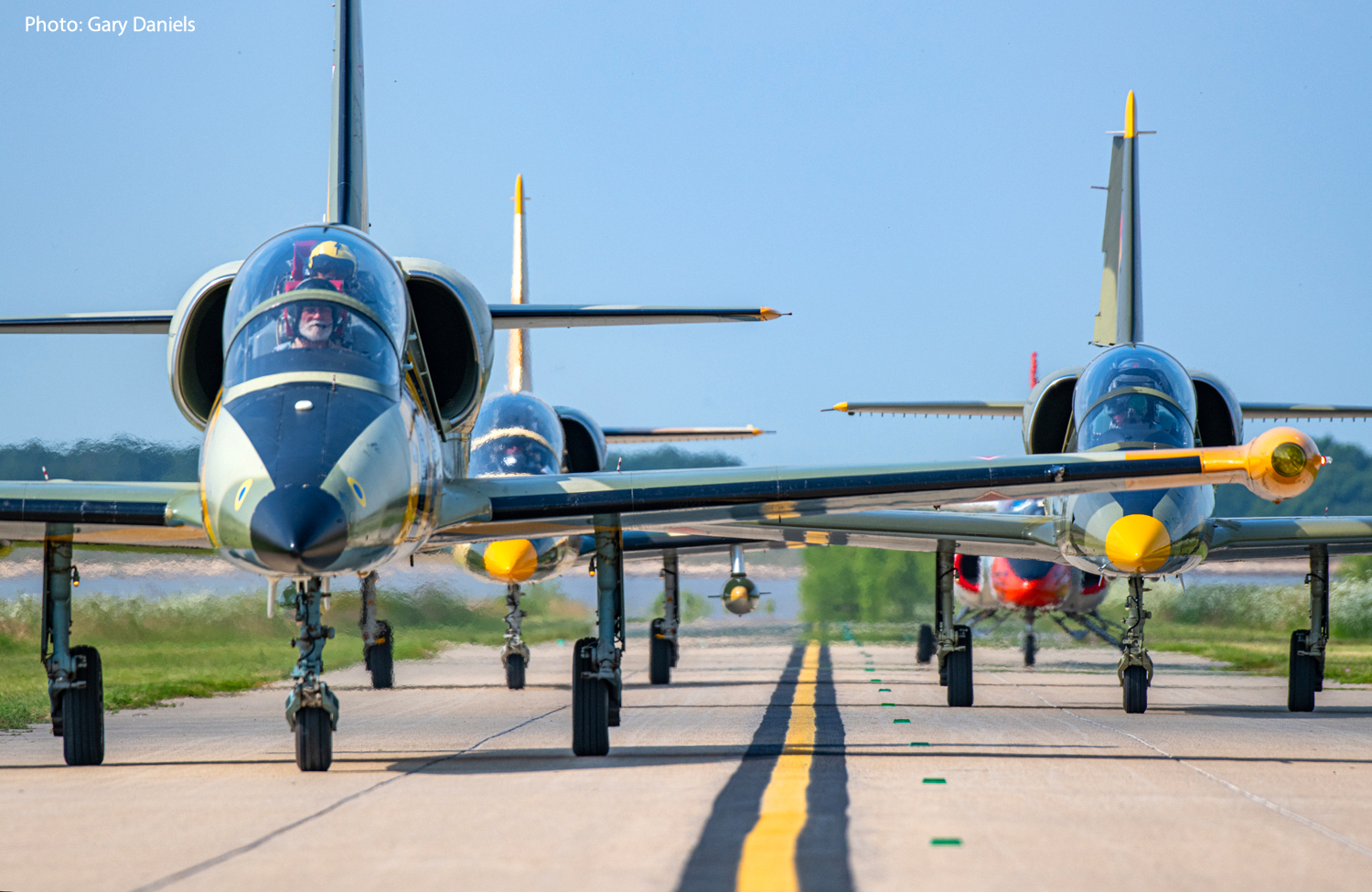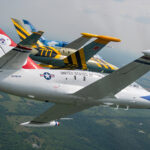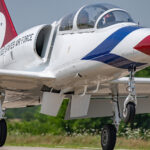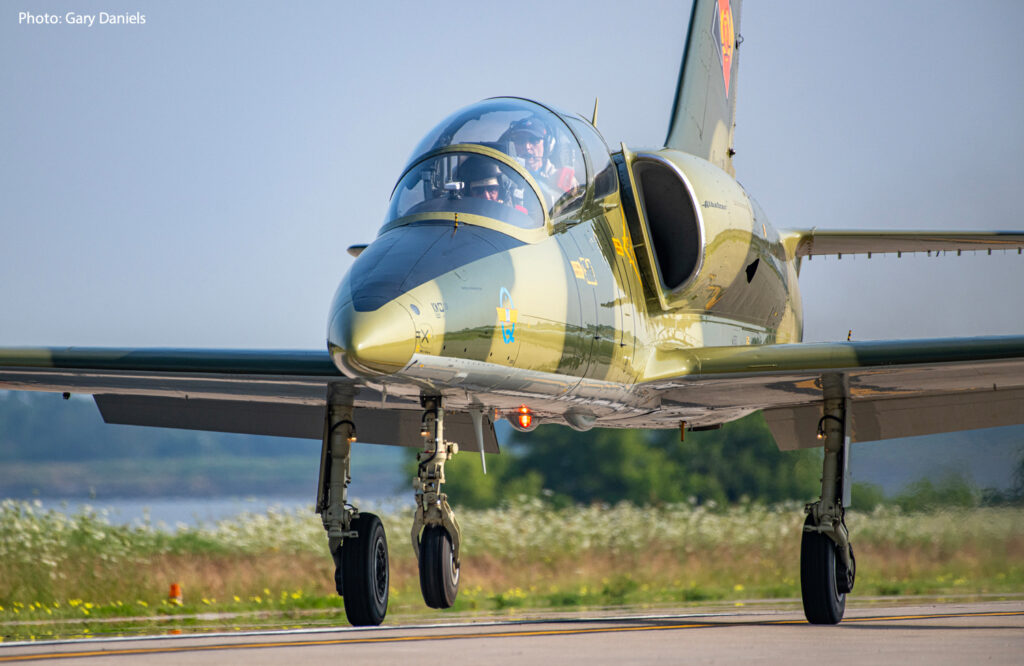Story and Photography by Gary Daniels
The fourth annual Classic Jet Aircraft Association (CJAA) Texas Jet Blast Formation Clinic took place over the Memorial Day weekend (May 25-28) at the Sulphur Springs Municipal Airport (KSLR) in Sulphur Springs, Texas. Aircraft began arriving on Wednesday evening, and by Thursday morning, twelve jets were on the ramp. The lineup was impressive with eight Cold War era Czech Aero Vodochody L-39 Albatros’, an Aero Vodochody L-29 Delfin, a British BAC Jet Provost Mk 5, an Italian SIAI-Marchetti S.211, and a French Fouga CM.170 Magister.
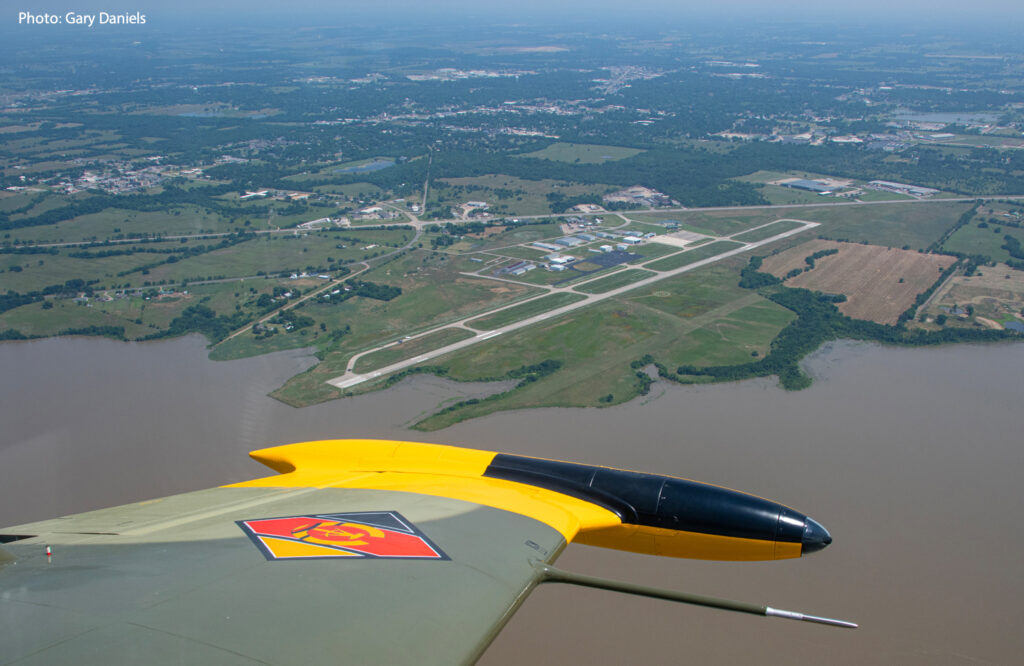
Russell Armstrong is a CJAA member and the Texas Jet Blast event coordinator. He has organized all four Texas Jet Blast events, the first held in November 2019. Russell lives in Commerce, Texas, about 30 minutes from Sulphur Springs and has been flying since he was a teen. In 2017, he became a jet owner and has been hooked on “the need for speed” ever since.
For Russell, deciding on the location of the Texas Jet Blast was the easiest decision in the planning. Russell has known Joey Baker, KSLR Airport Manager, for many years. Joey was named 2021 Texas Airport Manager of the Year, a title well deserved. Russell said, “When I originally asked Joey if he was interested in having the CJAA event at KSLR, he was instantly on board and was integral in helping plan the event. Each year, Joey, his assistant Cristie Kopal, and his airport staff are instrumental in the success of our event.” KSLR has a 5000 x 75 feet concrete runway, a large ramp space, and plenty of Jet-A for the thirsty jets. Two practice areas were also designated. ‘Charlie’ was 10 miles north of KSLR, and ‘Delta’ was 10 miles south. Both were approximately 25 miles long by 15 miles wide so that the jets could do air work at altitudes between 6,000 to 15,000 feet. Formation flights were conducted below 250 Knots Indicated Air Speed (KIAS) up to 10,000 feet MSL (Mean Sea Level), and at times, more than 250 KIAS above 10,000 feet MSL.
By Thursday mid-morning, the first briefing was completed, and crews were heading to their jets to punch holes in the warm and humid east Texas sky. Over the course of the weekend fourteen formation sorties were flown, keeping the Charlie and Delta practice areas occupied. Working on lead and wing work was the primary focus. Once in the practice areas, pilots practiced Formation and Safety Team (FAST) formation maneuvers using hand signals for communication between aircraft and radio comms only if needed. Maneuvers included Echelon Turns, wing work in Fingertip, Close Trail, Lead Change, Cross Under, Extended Trail Chase, and others. Formations were also flown practicing Echelon, Parade, Vic, Finger 4, and Diamond formations. For the pilots, this was a real thrill having the opportunity to fly their jets in formation, individual wing work, and for those new to formation flying, to have an instructor on board to give advice and encouragement.
Attending the Texas Jet Blast was a blend of CJAA member pilots and instructors. The experience, knowledge base, and skill level present were exceptional. Sonny Schilleci, CJAA president, added additional clarity to the Jet Blast mission, “As president, it is my responsibility to make sure events are organized and executed in accordance with CJAA guidelines and ensure the safety of those involved. Our Jet Blast events bring pilots, flying a variety of classic jets, together to share in comradery, training, and the spirit of aviation. The goal is to promote the proficient and safe operation of classic jet aircraft. We train in a very structured and controlled ground and flight environment with safety as our number one priority. Many of our members also come from being proficient at formation flying in piston aircraft, and we help them transition to flying formation at the higher speeds and performance of jet aircraft. In order to fly in FAA wavered airspace, a FAST Card is required to be held by the pilot operating the aircraft in that airspace. Our Jet Blast events provide pilots the opportunity to train from beginner to advanced levels of formation proficiency to earn a FAST Wing or Lead Card certification. Holding either of these credentials allows pilots to fly their jets in a formation (2-ship, 3-ship, 4-ship, or greater) in waivered airspace like an air show, Oshkosh, or Sun-N-Fun for example.”
Armstrong added, “If a classic jet owner intends to carry passengers, he must have a 61.58 Pilot in Command Proficiency check ride annually. Zach McNeil, FAA Designated Examiner (DE), attended the Texas Jet Blast and checked-off three attending pilots for their 61.58.”
Russell also worked with the FAA to establish a 7000-foot long by 3000-foot-wide surface to 8000 feet MSL aerobatic box with several FAR’s waived, speed and altitude restrictions among others. During the event, the aerobatic was activated eight times for members to practice their routines. Some of the CJAA members hold ICAS (International Council of Air Shows) Aerobatic Cards in their classic jets. There is an 800’ AGL (Above Ground Level) Card, a 500’ AGL Card, and a Surface Card. Members must have a ICAS Aerobatic Card, issued by an ACE (Aerobatic Competency Examiner), in order to perform aerobatics in a waivered air space. ACE Randy Ball attended the Texas Jet Blast on Saturday and renewed an ICAS 800’ Card for Alfred ‘Boards’ Maldanado in his Fouga Magister. Randy Ball holds a Surface ICAS Card in his Mig-17F and has performed in more than 1500 airshows. Bill ‘Popeye’ Culberson holds a 500’ ICAS Aerobatic Card in his L-29 Delfin, MiG-15, MiG-17, and Lockheed T-33. He tore up the box in his L-29.
The CJAA was founded in 1989 to create an association to represent the classic jet community. Today, the CJAA has approximately 240 members representing more than 30 surplus military turbine-powered aircraft types, from ex-US military fighters and trainers to various makes of foreign jets. A key component of the CJAA mission states, “CJAA will also demonstrate our commitment to the safe and professional operation of our aircraft by the continuous development of safety, training and maintenance programs…” A CJAA Jet Blast event is designed to teach enhanced flying skills to member pilots and strengthen the classic jet community. Jet Blasts are focused on aircraft-specific training and checkout, general safety training, FAST, proficiency checks, and aerobatic instruction. CJAA conducts, on average, six to eight Jet Blast events annually at various locations in the United States.
In the United States, there are approximately 1,000 privately-owned classic jets. And, the numbers are growing! The FAA closely regulates the ownership and operation of these aircraft. Many jets have restrictions placed on them which dictate where they may be flown and for what purpose. Most are licensed in the “Experimental and Exhibition” category, which means that they can only be flown to and from air shows and displays, for pilot proficiency and other specific activities. They may not be used as “personal transportation” aircraft. Currently, the CJAA is working with the FAA to rewrite regulations affecting classic jet operations.
Many of the owners/operators of these aircraft have backgrounds in military aviation, and others have hundreds of hours of flying time in civilian-operated jet aircraft. There are stringent, government-mandated pilot training requirements. New jet owners often find other CJAA members to be valuable sources of information and experience.
Many of the classic jets have been imported from other countries like Canada, France, Poland, Czechoslovakia, Russia, Yugoslavia, and others. When these countries remove the aircraft from their military inventories, they occasionally make them available on the worldwide market. Some have been imported to the U.S. where they are assembled, restored, inspected, certified, and sold to private owners, collectors, and museums.
Owning a classic jet is not for the faint-hearted. Getting ‘in the game’ may seem like a bargain with some of the jets going for as little as $30-50k. But, the low initial acquisition cost of these aircraft is offset by higher operating costs. Many of the older turbojet engines gulp in excess of 200 gallons per hour. More expensive jets, like the L-39, with the medium bypass turbofan engines are more efficient but still burn 140-160 gallons per hour in high altitude cruise. At today’s Jet-A fuel costs that comes mighty close to $1000 per hour of flight time. Multiply that by 100 or so hours of flying a year and a classic jet can drink up a college fund, not to mention avionics upgrades, and various maintenance issues to consider. But, like any other activity that is a passion, the expense is insignificant compared to the sheer thrill provided by piloting a high-performance jet aircraft. Ask any of the pilots that attended the Texas Jet Blast!
At the Texas Jet Blast, these aviators came together in the true spirit of aviation, at their own expense, to advance their flying skills in the unique aircraft category of classic jets. The consensus of all involved in the Texas Jet Blast was…well…it was a BLAST!







